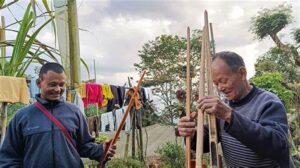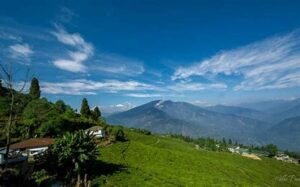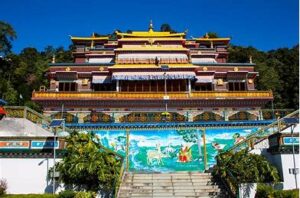Introduction
In the evolving landscape of Indian contemporary art, voices from the Northeast have gradually begun to claim their well-deserved space. Among them, Ejanbemo Yanthan, a modern sculptor from Dimapur, Nagaland, stands out as a powerful figure. Revered for his distinctive sculptural forms and for reviving traditional Naga expressions through modern art mediums, Yanthan has carved a niche for himself not just in his home state but also in the larger Indian art scene.
This blog delves into the artistic journey of Ejanbemo Yanthan, his contributions to the sculptural heritage of Nagaland, and his role in nurturing the state’s vibrant artistic community.
Nagaland: A Tapestry of Culture and Creativity
To appreciate the significance of Yanthan’s work, one must first understand Nagaland’s cultural context. Nestled in the far northeastern corner of India, Nagaland is home to a multitude of tribes, each with its own unique customs, dialects, crafts, and folklore. Wood carving, weaving, and traditional forms of craftsmanship have always been integral to Naga identity.
Dimapur, where Ejanbemo Yanthan is based, is the cultural and commercial hub of Nagaland. Over the years, the city has fostered a small but robust community of painters, sculptors, and mixed-media artists. Within this emerging ecosystem, Yanthan has become one of the most recognized modern sculptors.
The Early Life of Ejanbemo Yanthan
Ejanbemo Yanthan hails from the Lotha Naga tribe, known for its deep-rooted traditions, ceremonial art, and community-based storytelling. Growing up amidst rich cultural tapestries and folk narratives, Yanthan developed an early fascination with visual storytelling and three-dimensional forms.
Though not much is publicly documented about his formal training, it’s evident that his artistic abilities were shaped by both indigenous wisdom and a keen engagement with contemporary art practices. His experimentation with materials, textures, and techniques highlights a self-taught brilliance informed by grassroots learning and cultural immersion.
Sculptural Style and Artistic Philosophy
Yanthan’s sculptures are not just aesthetic objects—they are narratives in form. His art is defined by:
- Cultural Memory and Identity
Many of his works reflect themes inspired by Naga folklore, oral history, tribal deities, and community rituals. These elements are not merely reproduced but are reinterpreted through a modern lens, offering new meaning to traditional symbols.
- Material Versatility
He works across a variety of mediums, including:
- Plaster of Paris
- Clay
- Cement
- Fiberglass
- Wood
This versatility allows him to experiment with textures and durability, giving his sculptures a dynamic character.
- Abstracted Realism
While some of his sculptures veer towards figurative realism, others adopt abstract motifs, blurring the line between contemporary expression and indigenous symbolism. His forms often feature elongated limbs, distorted facial features, and exaggerated gestures, invoking spiritual or mythological dimensions.
Notable Works and Exhibitions
Though Ejanbemo Yanthan is not a mainstream celebrity artist, his works have been featured in several local art exhibitions across Nagaland and Northeast India. His sculptures often attract attention for their bold scale, symbolic depth, and haunting serenity.
Highlights include:
- Sculptures of Tribal Elders – Honoring the wisdom and grace of Naga village elders.
- Hornbill-inspired Figures – Reinterpreting the symbolic bird often associated with strength, pride, and the famous Hornbill Festival.
- Spiritual Guardians – Abstract forms representing mythological spirits or guardians that watch over tribal communities.
These works are often displayed at state-run galleries, community art fairs, and cultural exhibitions organized by institutions like the North East Zone Cultural Centre (NEZCC) and Tribal Research Institute.
Contribution to Nagaland’s Artistic Renaissance
In many ways, Ejanbemo Yanthan is part of a renaissance movement in Nagaland. While older generations have focused on preserving traditional crafts, a newer generation of artists—sculptors, photographers, painters, and digital creatives—is reinterpreting these traditions through contemporary lenses.
His contributions include:
- Mentorship and Inspiration
Young artists in Dimapur and surrounding areas often cite Yanthan as a mentor figure. He is known to support local workshops, art meet-ups, and informal learning spaces where ideas and techniques are freely shared.
- Preservation Through Innovation
By modernizing traditional themes, Yanthan helps ensure that cultural memory is not lost, even as mediums evolve. His work becomes a bridge between generations, connecting ancestral knowledge with urban sensibilities.
- Cultural Diplomacy
In a state where the arts are still emerging as a viable career, Yanthan’s success demonstrates that cultural work matters—both economically and socially. His sculptures are often used to represent Nagaland at national-level cultural showcases, including India’s Republic Day tribal displays and state-sponsored events in Delhi and Guwahati.
The Artistic Landscape of Dimapur
Dimapur has become a hotbed of creativity in recent years. Apart from being Nagaland’s commercial center, it also hosts a rising number of:
- Art galleries
- Public murals
- Cultural festivals
- Artist collectives
Artists like Yanthan thrive here not just due to the availability of materials and space, but also because of the growing appetite for local, authentic, and culturally rooted art.
Institutions such as:
- Nagaland Art and Culture Department
- NEZCC (North East Zone Cultural Centre)
- Tribal Art Resource Centres
…have played an instrumental role in supporting this ecosystem.
Challenges and Resilience
Despite his achievements, Yanthan’s journey hasn’t been without challenges. Being a professional artist in Nagaland comes with its own set of limitations:
- Lack of infrastructure for large-scale sculpture production
- Limited access to national art platforms and galleries
- Minimal government grants or recognition for modern sculptors
Yet, Yanthan has persevered, driven by a sense of purpose. His art is not about fame—it’s about telling stories, provoking thought, and preserving a way of life.
The Future of Sculptural Art in Nagaland
Thanks to artists like Ejanbemo Yanthan, the future of sculpture in Nagaland looks promising. With growing interest in tribal art forms, increased tourism via events like the Hornbill Festival, and rising awareness about Naga heritage, the space for sculptural arts is expanding.
Potential Developments Include:
- Art residencies where Naga sculptors collaborate with national and international artists.
- Public sculpture installations in Dimapur and Kohima.
- Digital galleries and NFTs showcasing Naga sculptural art.
- Art education modules that include indigenous techniques and sculptural philosophy.
Final Thoughts
Ejanbemo Yanthan is more than a sculptor—he is a cultural custodian, visual storyteller, and a quiet revolutionary in Nagaland’s creative journey. Through his sculptures, he invites us to pause, reflect, and rediscover the stories hidden within tribal wisdom.
His contribution serves as a reminder that art rooted in local culture can have universal appeal. Whether you’re an art enthusiast, a student of cultural history, or simply someone curious about the creative pulse of Northeast India, Ejanbemo Yanthan’s work offers a profound and moving entry point.






